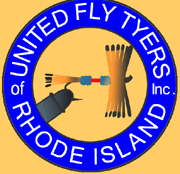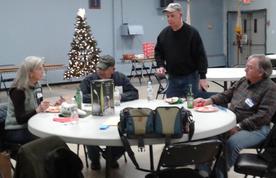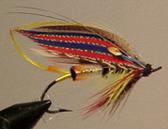United Fly Tyers of Rhode Island, Inc.
Black and Gold Salmon Fly
Tied by: John O'Meara
Tag: Silver twist and gold floss
Tail: A topping and Indian Crow
Butt: Black Ostrich herl
Body: In two equal sections, First half: Gold tinsel ribbed with silver oval tinsel with Indian crow above and below, and butted with black Ostrich herl. Second half: Black silk ribbed with silver oval tinsel
Hackle: Gold hackle over the black silk from second turn
Throat: Claret hackle and Jay
Wings: Dark turkey with white tips, bustard, red macaw, light mottled turkey, mallard, swan died red and blue, and two toppings
Sides: Jungle cock
Cheeks: Chatterer
Horns: Blue Macaw
Head: Black Berlin wool
As tiers, we can certainly appreciate what goes into a classic salmon fly. Or do we?
I’d like to mention a few things about classic salmon flies that may help increase your appreciation of a classic done well. From selecting the hook, to finishing the head, every step in constructing a classic should be well thought out well in advance if we are to end up with a classic.
In their order of appearance in the tying procedure, the materials are:
The hook. Most salmon hooks are handsome devices. In this particular example, the Black & Gold is tied on a Bartleet CS 10/1, size 2. The hook has a slight curve to the shank, which enhances the grace and flow of the fly. It is a loop eyed hook, (as opposed to a blind eyed hook which requires a gut eye to be fashioned.)
The tag, which is the first thing that we tie on consists of two parts, the very brief tinsel wraps, (usually four wraps maximum). This is usually very fine and shiny silver or gold. The second part is a silk floss which is wound up to, but not past, the point of the hook. It should have a gradually increasing taper.
Next, we add the tail, usually a short golden pheasant topping with various veilings, in this case an Indian crow substitute. (A veiling is any feather placed over another major component.) It is important to notice the location of the tip of the tail. In most cases, it will be slightly behind the bend of the hook, and between one, to one and one half times the hook gap high. This is probably the most important measurement to be made in tying any salmon fly. The point where the tail ends is the same point where the tip of the wing and the tip of the topping meet. This point sets the attitude of the entire fly.
To hide the bulk created by the stems of the tail and its veiling, we use a herl butt. The herl butt consists of no more than four turns of very fine herl, (from near the top of the plume.) The fibers should point toward the rear. This allows each wrap to be placed closely to the preceding wrap, and ultimately the rib and silk of the body to be placed right up against the edge of the herl, making for a very tidy transition.
The majority of classics have tinsel ribbing. Usually it’s a simple oval silver or gold. This is tied in so that the first wrap will come from the bottom of the fly. Traditionally the tinsel is wrapped forward in five turns.
Before tying in the material for the body, the tier might want to taper the body to a cigar shape. This is done with inexpensive rayon floss which will never be seen. This taper adds considerably to the overall appearance of the fly, (a touch of class if you will.)
In this case the first half of the body is a flat gold tinsel, ribbed with a silver oval tinsel, and veiled top and bottom with Indian crow substitute.
Again, the lumps created by the stems of the veiling are hidden by a herl butt.
The second half of the body, in this case, consists of black silk ribbed with silver oval tinsel. Again, the herl should point toward the rear, and the oval tinsel should be tied in right up to the edge of the herl so it can begin from the bottom and wrap forward for five turns.
Whenever a hackle is wrapped over a silk, or dubbed body, the hackle usually starts from the bottom with the second wrap of the tinsel ribbing.
The body is finished with the beard, or throat. In this case, a claret hackle, followed by a guinea fowl body feather. The beard should sweep back toward, but not reach the point of the hook.
Now we’re ready to tie in the wings. Most classic salmon flies have an underwing, in this case, white tipped turkey. This white tipped turkey is used on several classics. (More popular is the golden pheasant tippet underwing.)
Our overwing consists of fibers of several different birds and colors. The recipe dictates the colors and the sequence of color.
A typical overwing consists of approximately 24 to 30 fibers of the various feathers dictated by the recipe. Although the recipe dictates the order of the materials, the tier is allowed a certain artistic license. In this case, I’ve chosen to use more red than blue and placed the bulk of it nearer the bottom of the wing where it has more visibility. I’ve also chosen to use the light mottled turkey on the bottom of the wing. Since the majority of the fibers in these wings are goose, (more vibrant in color and softer than turkey) the heavier turkey fibers would crush the goose when tied in place if they were on the top.
The finishing touches on this fly consist of a golden pheasant topping over all, jungle cock cheeks, veiled with blue chatterer. At this point it might be good to mention that any fibers on the left (or near side) of the fly should come from the left side of the feather, and vice versa. Also, any small feather like jungle cock or chatterer on the left side (or near side) should come from the left side of the pelt. This will allow the feathers to sweep back and downward slightly, adding to the grace of the fly.
The mallard roof is a simple looking little feature. However, nothing that comes from a mallard is easy to work with. Again, the long fibers from the left side of one feather should be joined with the long fibers from the right side of another, to form a tent, or roof, to sit on top of the entire wing, left fibers on the left, (or near side) of the fly.
The horns are single fibers of the Macaw tail feathers, (left on left side etc.) They should emit from the head and angle upwards toward the topping, crossing the topping just before the base of the tail.
Finally, rather than a glossy black head as seen on many other classics, the heads of Irish flies are usually made of dubbed Berlin wool, or black Ostrich herl.
In closing, a good rule of thumb in identifying any classic salmon fly is to look closely at the body, not the wings. In this case, “Black and Gold” refers to the colors of the body not the wings. The Black and Gold is one of a family of old Irish patterns. The other members of the family are the Black and Orange, and the Black and Claret.
Other good examples are the Doctor series. The Silver Doctor has a silver body. The Black Doctor has a black body, etc. Their wings are very much alike, and all have red heads.
Most Irish flies are rather drab in color compared to their Welsh and British counterparts. Although drab, they produced great results on the Irish rivers. This fly was originated in the late 1800’s when Lincoln was president. An Irish gentleman by the name of O’Fee is credited with its origin
The flies of the Black & Gold family are some of the earliest classic Irish flies using the colors and flash of the British and Welsh flies. It was around this time that some of the more colorful and flashy materials available elsewhere were beginning to make their way into this poverty stricken part of the world.
I hope this little exercise will allow each of you to view Classic Salon Flies from a new perspective in the future.
John O'Meara


